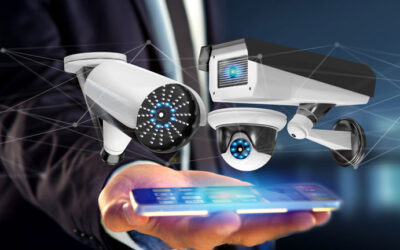The significance of choosing the right access control system for your business cannot be overstated. Gone are the days when a simple lock-and-key mechanism sufficed to secure our enterprises. We’ve witnessed a remarkable evolution in how we safeguard our commercial spaces, transitioning from traditional methods to sophisticated electronic systems that not only enhance security but also elevate operational efficiency.
As someone deeply entrenched in the security industry, I’ve seen firsthand the transformative impact these advanced systems have had on businesses of all sizes. Choosing the right access control system does more than just restrict entry; it becomes an integral part of a business’s operational backbone, streamlining processes and ensuring that only the right individuals have access to sensitive areas. This evolution reflects our broader shift towards a more interconnected and digitalised business landscape, where security measures must be as dynamic and adaptable as the businesses they protect.
Understanding Access Control Systems
At its core, an access control system serves as the guardian of your business’s premises, regulating who can enter and exit various areas within your organisation. This mechanism is pivotal not just in safeguarding physical assets and critical data but also in protecting the well-being of your personnel. In an era where security breaches can have devastating repercussions, the role of an access control system transcends traditional security measures, acting as a vital component of your business’s overall risk management strategy.
The Shift from Mechanical to Electronic Access Control
The transition from mechanical locks to electronic access control systems marks a significant milestone in the realm of security. This evolution brings forth a suite of advantages that traditional keys simply cannot offer. Electronic systems provide unparalleled security, eliminating the risks associated with lost or duplicated keys. Moreover, they offer a level of convenience and control that is essential in today’s fast-paced business environment. With electronic access control, administrators can instantly grant or revoke access rights, monitor entry and exit in real-time, and even set custom access schedules. This shift not only enhances security but also introduces a level of flexibility and efficiency that is vital for modern businesses.
The Role of Access Control in Modern Business Operations
In contemporary business operations, access control systems are not merely a security feature; they are integral to the very fabric of building management and operations. These systems streamline access to facilities, ensuring that employees and authorised visitors can move through spaces seamlessly while keeping unauthorised individuals at bay. This integration of access control with other building systems, such as HVAC and lighting, further optimises operational efficiency and energy usage, making it a cornerstone of smart building management. The strategic implementation of access control systems thus not only bolsters security but also significantly contributes to the operational prowess of a business, marking a new era in how we perceive and implement security measures in the business landscape.
Advanced Features in Access Control Systems
The landscape of access control systems is constantly evolving, with advanced features being developed to meet the growing demands for tighter security and more efficient operations. As we delve into the future of security, it becomes evident that innovation is key to staying ahead of potential threats.
Biometric Readers: The Future of Security
Biometric readers stand at the forefront of this innovation, offering a level of security that is difficult to replicate or breach. These systems utilise unique biological characteristics, such as fingerprints, facial features, and iris patterns, to grant access, thereby significantly reducing the risk of unauthorised entry. The integration of biometric technology into access control systems has not only enhanced security but also introduced additional health safety measures. For instance, thermal imaging can be incorporated to detect elevated body temperatures, adding a layer of health security in today’s climate. The use of biometrics in access control is a testament to how security technology can adapt and evolve to meet contemporary challenges, ensuring that businesses are safeguarded against both traditional and emerging threats.
Enhancing Security with Video Analytics
The synergy between video analytics and access control systems represents another leap forward in comprehensive security solutions. By integrating video analytics, access control systems can now offer more than just entry and exit monitoring. They can identify anomalies, track patterns, and provide visual confirmations of access events, creating a more secure and intelligent surveillance ecosystem. This integration allows for real-time responses to potential security breaches, such as tailgating or unauthorised access attempts, thereby significantly enhancing the overall security posture of a business. The combination of video analytics and access control systems exemplifies the dynamic nature of security technology, ensuring that businesses are not just reactive but proactive in their security measures.
Choosing the Right Type of Access Gate
Selecting the appropriate type of access gate is a critical decision in the design and implementation of an effective access control system. Each type of gate comes with its unique set of features, catering to specific security needs and space constraints. It’s imperative to understand the nuances of each to ensure your choice aligns with your business’s requirements.
Types of Access Gates and Their Specific Needs
- Swing Gates: Ideal for businesses looking for an elegant and straightforward solution, swing gates are commonly used where space permits for the arc of the gate’s movement. They can be tailored for single or double entry and are suitable for environments that prioritise aesthetic appeal alongside functionality.
- Slide Gates: Slide gates are the go-to option for premises with limited space that cannot accommodate the swing arc of traditional gates. Operating horizontally along a track, they provide robust security without the spatial demands of swing gates, making them a practical choice for compact areas.
- Bi-Folding Gates: Bi-folding gates, known for their rapid opening and closing, are suitable for high-traffic areas where speed is of the essence. Their ability to fold onto themselves minimises space usage, making them an excellent option for sites where swift access is crucial without compromising on security.
- Vertical Lift Gates: When horizontal space is at a premium, vertical lift gates offer a solution by moving directly upwards. This type of gate is particularly useful in urban settings or where immediate adjacent access is required, ensuring that security measures do not impede operational efficiency.
- Pedestrian Gates: Designed specifically for foot traffic, pedestrian gates ensure that individuals can enter and exit securely without the need for larger vehicular gates. These gates are essential in managing access in mixed-use areas, providing a secure, controlled entry point for personnel and visitors while maintaining the flow of foot traffic.
Choosing the right type of access gate involves a careful consideration of your business’s specific security requirements, the physical layout of the premises, and the expected flow of traffic. Each gate type offers distinct advantages, and selecting the most suitable one is a critical step towards creating a secure and efficient access control system.
Tailoring Access Control to Industry Needs
Access control systems are not one-size-fits-all solutions. Different industries have unique security and operational requirements that necessitate bespoke access control strategies. Let’s delve into how various sectors tailor these systems to meet their distinct needs.
Access Control Across Industries
Government: In government facilities, where security is paramount, access control systems must offer the highest level of protection without compromising efficiency. Advanced biometric systems and multi-factor authentication are commonly employed to protect sensitive information and ensure that only authorised personnel can access restricted areas. These systems are often integrated with comprehensive surveillance and alarm systems to provide a layered security approach.
Enterprise: For enterprise environments, particularly in corporate offices, access control systems need to balance security with accessibility. Systems in these settings often include smart card technologies and mobile access solutions, allowing for seamless integration with other business systems like HR databases. This integration facilitates efficient management of employee movements, guest access, and even time and attendance tracking.
Education: Schools and universities present unique challenges, requiring systems that protect students and staff while maintaining an open and welcoming environment. Access control in educational institutions often involves tiered access levels, with more stringent controls for laboratories and administrative offices. Additionally, lockdown capabilities are crucial for emergency situations, enabling swift action to secure students and staff.
Worship Centres: Places of worship require a delicate balance between being open and accessible to the community while protecting congregants and property. Access control systems in these environments are typically more discreet, focusing on controlling access during off-hours and monitoring areas that are susceptible to vandalism or theft. Video intercoms and remote access capabilities allow for a flexible yet secure approach, accommodating varied schedules and events.
In each sector, the approach to access control is shaped by the industry’s specific needs and challenges. By tailoring systems to these requirements, businesses and institutions can ensure a secure yet functional environment that aligns with their operational objectives and cultural values.
Step-by-Step Guide to Selecting an Access Control System
Selecting the right access control system for your business is a nuanced process that requires a deep understanding of your specific security needs and operational demands. Let’s walk through a structured approach to ensure you make an informed decision that aligns with your long-term security objectives.
Assessing Your Security Needs
The first step in choosing an access control system is to conduct a thorough assessment of your security needs. Begin by identifying the scope of the system — do you need it for a single entry point or multiple access areas across different locations? Consider the nature of the spaces that require protection, such as offices, data centres, or storage areas, as each may have different security requirements. Evaluate potential threats and determine the level of security needed for each area. It’s crucial to involve stakeholders from various departments to gain a comprehensive view of your organisation’s security needs, ensuring that the system you choose addresses all potential vulnerabilities.
Authentication Methods and System Integration
The choice of authentication methods is pivotal in defining the effectiveness and user experience of your access control system. Options range from traditional keypads and card readers to more sophisticated biometric systems that offer higher security levels. The selected method should align with the sensitivity of the areas being protected and the ease of use for authorised personnel.
Equally important is the system’s ability to integrate with your existing security infrastructure. A seamless integration enhances overall security and operational efficiency, allowing for centralised management of various security components. Consider systems that offer compatibility with your existing video surveillance, alarm systems, and even HR management systems for a cohesive security strategy.
Future-Proofing Your Access Control System
In an ever-evolving security landscape, future-proofing your access control system is essential. Opt for systems that are adaptable and scalable, capable of accommodating your business’s growth and the integration of new technologies. Features like mobile access and visitor management systems are becoming standard, offering flexibility and improved security. Moreover, as biometric solutions continue to advance, choosing a system that can support or is already equipped with such technologies ensures longevity and relevance in the face of emerging security challenges.
In selecting your access control system, consider not just the immediate needs but the future trajectory of both your business and technological advancements. This foresight will safeguard your investment and ensure that your security infrastructure remains robust and adaptable for years to come.
Implementing Your Access Control System
Once you’ve selected the right access control system for your business, the focus shifts to effective implementation. Proper installation and maintenance are crucial for ensuring the system’s reliability and longevity, while being prepared to overcome common challenges can streamline the process and enhance overall security.
Installation and Maintenance Best Practices
The installation of your access control system should always be conducted by professionals with expertise in the specific system you’ve chosen. This ensures that all components are correctly configured and optimised for your particular environment. Key considerations during installation include the strategic placement of readers and cameras, ensuring all entry points are covered without creating bottlenecks or compromising convenience.
Maintenance plays a pivotal role in the ongoing effectiveness of your access control system. Regular checks and updates are essential to ensure the system functions correctly and remains secure against evolving threats. This includes software updates, hardware inspections, and testing backup systems to guarantee performance during power outages or network disruptions.
Overcoming Common Challenges
Implementing an access control system can present several challenges, from technical issues to user resistance. One common hurdle is integrating the new system with existing security infrastructure without causing disruptions. Solutions include phased rollouts, where the system is implemented in stages, and choosing systems known for their compatibility with a wide range of technologies.
Another challenge is ensuring that all users are adequately trained and comfortable with the new system. This can be addressed through comprehensive training sessions and the provision of clear, accessible user guides. Additionally, consider the user experience in your system’s design to minimise resistance and encourage compliance.
Finally, businesses must be prepared for the potential of system breaches or technical failures. Implementing robust security protocols, such as multi-factor authentication and regular system audits, can mitigate these risks. Having a clear response plan in place for security breaches or system outages will ensure that any issues are swiftly and effectively resolved, minimising impact on your business operations.
By adhering to best practices for installation and maintenance and being prepared to tackle common challenges head-on, your access control system will serve as a cornerstone of your business’s security strategy, providing peace of mind and a secure environment for your operations to thrive.
Key Takeaways
In navigating the complex landscape of business security, the choice of an access control system emerges as a pivotal decision. This guide has traversed the essential steps, from understanding the basic tenets of access control to the nuanced process of selecting, implementing, and maintaining a system that aligns with your unique business requirements.
The transition from traditional to electronic access control systems underscores a broader shift towards more secure, efficient, and adaptable business operations. With features like biometric authentication and video analytics, modern access control systems offer a level of security that is sophisticated, yet intuitive, meeting the diverse needs of various industries—from government and corporate enterprises to educational institutions and places of worship.
Selecting the right type of access gate, tailored to your spatial and operational needs, further exemplifies the customisability and versatility of contemporary access control solutions. Moreover, the discussion on industry-specific applications highlights the importance of a bespoke approach, ensuring that the system you choose not only secures your premises but also complements the unique dynamics of your industry.
Wrap-Up
The implementation of an access control system is more than a security measure; it’s an investment in the future-proofing of your business. Beyond safeguarding assets and personnel, a well-chosen and expertly implemented access control system enhances the efficiency and operational capabilities of modern businesses. It streamlines processes, reinforces risk management strategies, and supports a secure, dynamic working environment.
In an era where the threats to business security are as diverse as they are dynamic, the role of access control systems in underpinning a comprehensive security strategy cannot be overstated. By adopting a system that is as adaptable and scalable as it is secure, businesses can not only protect themselves against current threats but also adapt to future challenges, ensuring resilience and continuity in an ever-evolving business landscape.
FAQs
Q1: What is an access control system? A1: An access control system regulates who can enter and exit various areas within your organization, safeguarding physical assets, critical data, and ensuring the well-being of your personnel.
Q2: Why is it important to choose the right access control system for my business? A2: Choosing the right access control system enhances security, streamlines operations, and ensures that only authorized individuals have access to sensitive areas, thereby protecting your business from potential security breaches.
Q3: What are the benefits of electronic access control systems over traditional mechanical locks? A3: Electronic access control systems offer higher security by eliminating risks associated with lost or duplicated keys, providing real-time monitoring, instant access management, and enhanced operational efficiency.
Q4: How do biometric readers improve security in access control systems? A4: Biometric readers use unique biological characteristics, such as fingerprints or facial recognition, to grant access, significantly reducing the risk of unauthorized entry and ensuring a higher level of security.
Q5: What role do video analytics play in access control systems? A5: Video analytics enhance access control systems by providing real-time monitoring, detecting anomalies, tracking patterns, and offering visual confirmations of access events, thereby improving overall security.
Q6: What types of access gates are available, and how do I choose the right one for my business? A6: Types of access gates include swing gates, slide gates, bi-folding gates, vertical lift gates, and pedestrian gates. Choosing the right one depends on your security needs, space constraints, and traffic flow.
Q7: How can access control systems be tailored to different industries? A7: Access control systems can be customized with features like biometric authentication, multi-factor authentication, and integration with other security systems to meet the unique needs of industries such as government, enterprise, education, and worship centers.
Q8: What are some advanced features to consider when selecting an access control system? A8: Advanced features include biometric readers, video analytics, mobile access, visitor management systems, and integration with other building systems for enhanced security and operational efficiency.
Q9: How do I ensure that my access control system is future-proof? A9: Choose systems that are adaptable, scalable, and capable of integrating new technologies. Look for features like mobile access and support for advanced biometric solutions to ensure longevity and relevance.
Q10: What are the best practices for installing and maintaining an access control system? A10: Best practices include professional installation, regular maintenance checks, software updates, hardware inspections, and ensuring backup systems are functional to guarantee reliability and security.




